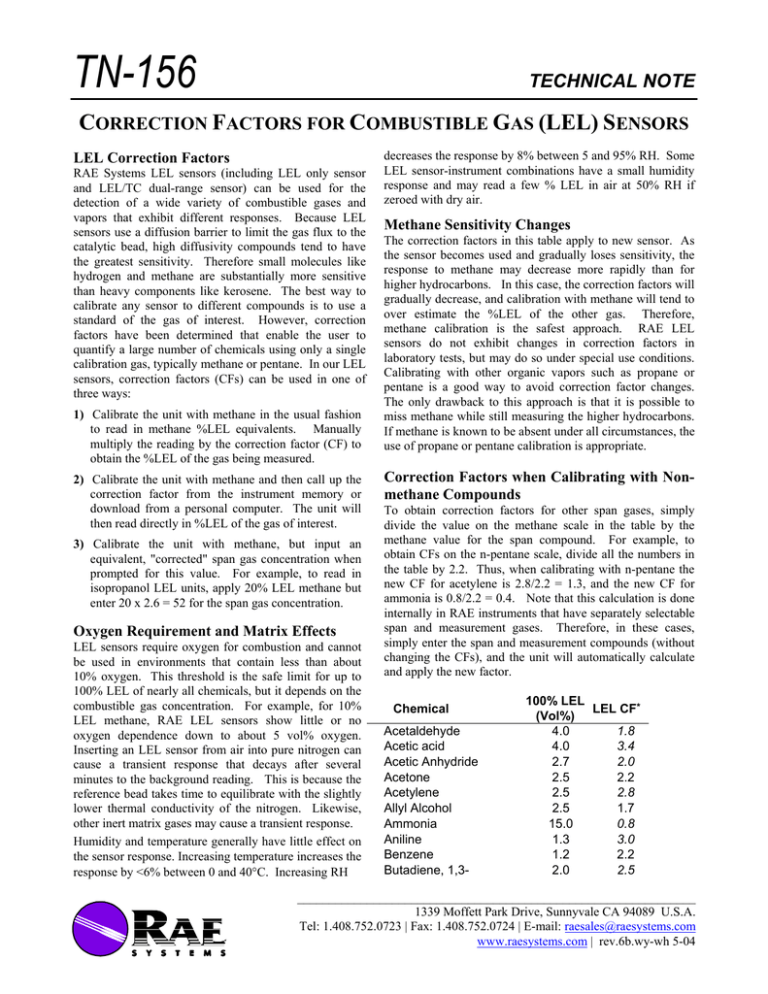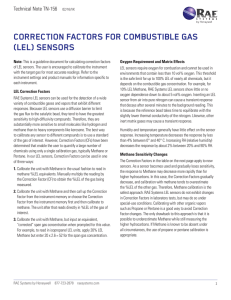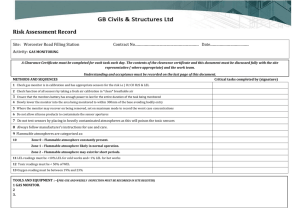Correction Factors for Combustible Gas (LEL) Sensors
advertisement

TN-156 TECHNICAL NOTE CORRECTION FACTORS FOR COMBUSTIBLE GAS (LEL) SENSORS LEL Correction Factors RAE Systems LEL sensors (including LEL only sensor and LEL/TC dual-range sensor) can be used for the detection of a wide variety of combustible gases and vapors that exhibit different responses. Because LEL sensors use a diffusion barrier to limit the gas flux to the catalytic bead, high diffusivity compounds tend to have the greatest sensitivity. Therefore small molecules like hydrogen and methane are substantially more sensitive than heavy components like kerosene. The best way to calibrate any sensor to different compounds is to use a standard of the gas of interest. However, correction factors have been determined that enable the user to quantify a large number of chemicals using only a single calibration gas, typically methane or pentane. In our LEL sensors, correction factors (CFs) can be used in one of three ways: 1) Calibrate the unit with methane in the usual fashion to read in methane %LEL equivalents. Manually multiply the reading by the correction factor (CF) to obtain the %LEL of the gas being measured. 2) Calibrate the unit with methane and then call up the correction factor from the instrument memory or download from a personal computer. The unit will then read directly in %LEL of the gas of interest. 3) Calibrate the unit with methane, but input an equivalent, "corrected" span gas concentration when prompted for this value. For example, to read in isopropanol LEL units, apply 20% LEL methane but enter 20 x 2.6 = 52 for the span gas concentration. Oxygen Requirement and Matrix Effects LEL sensors require oxygen for combustion and cannot be used in environments that contain less than about 10% oxygen. This threshold is the safe limit for up to 100% LEL of nearly all chemicals, but it depends on the combustible gas concentration. For example, for 10% LEL methane, RAE LEL sensors show little or no oxygen dependence down to about 5 vol% oxygen. Inserting an LEL sensor from air into pure nitrogen can cause a transient response that decays after several minutes to the background reading. This is because the reference bead takes time to equilibrate with the slightly lower thermal conductivity of the nitrogen. Likewise, other inert matrix gases may cause a transient response. Humidity and temperature generally have little effect on the sensor response. Increasing temperature increases the response by <6% between 0 and 40°C. Increasing RH decreases the response by 8% between 5 and 95% RH. Some LEL sensor-instrument combinations have a small humidity response and may read a few % LEL in air at 50% RH if zeroed with dry air. Methane Sensitivity Changes The correction factors in this table apply to new sensor. As the sensor becomes used and gradually loses sensitivity, the response to methane may decrease more rapidly than for higher hydrocarbons. In this case, the correction factors will gradually decrease, and calibration with methane will tend to over estimate the %LEL of the other gas. Therefore, methane calibration is the safest approach. RAE LEL sensors do not exhibit changes in correction factors in laboratory tests, but may do so under special use conditions. Calibrating with other organic vapors such as propane or pentane is a good way to avoid correction factor changes. The only drawback to this approach is that it is possible to miss methane while still measuring the higher hydrocarbons. If methane is known to be absent under all circumstances, the use of propane or pentane calibration is appropriate. Correction Factors when Calibrating with Nonmethane Compounds To obtain correction factors for other span gases, simply divide the value on the methane scale in the table by the methane value for the span compound. For example, to obtain CFs on the n-pentane scale, divide all the numbers in the table by 2.2. Thus, when calibrating with n-pentane the new CF for acetylene is 2.8/2.2 = 1.3, and the new CF for ammonia is 0.8/2.2 = 0.4. Note that this calculation is done internally in RAE instruments that have separately selectable span and measurement gases. Therefore, in these cases, simply enter the span and measurement compounds (without changing the CFs), and the unit will automatically calculate and apply the new factor. Chemical Acetaldehyde Acetic acid Acetic Anhydride Acetone Acetylene Allyl Alcohol Ammonia Aniline Benzene Butadiene, 1,3- 100% LEL LEL CF* (Vol%) 4.0 1.8 4.0 3.4 2.7 2.0 2.5 2.2 2.5 2.8 2.5 1.7 15.0 0.8 1.3 3.0 1.2 2.2 2.0 2.5 _______________________________________________________________ 1339 Moffett Park Drive, Sunnyvale CA 94089 U.S.A. Tel: 1.408.752.0723 | Fax: 1.408.752.0724 | E-mail: raesales@raesystems.com www.raesystems.com | rev.6b.wy-wh 5-04 100% LEL LEL CF* (Vol%) Butane, n1.9 2.0 Butane, i1.8 1.8 Butanol, n1.4 3.0 Butanol, i1.7 2.5 Butanol, t2.4 1.8 Butene-1 1.6 2.1 Butene-2, cis 1.7 2.1 Butene-2, trans 1.8 1.9 Butyric acid 2.0 2.4 Carbon disulfide 1.3 ** Carbon monoxide 12.5 1.2 Carbonyl sulfide 12.0 1.0 Chlorobenzene 1.3 3.0 Chloropropane, 12.6 1.8 Cyanogen 6.6 1.1 Cyclohexane 1.3 2.5 Cyclopropane 2.4 1.5 Decane, n0.8 3.4 Dichloroethane, 1,26.2 1.5 Dichloromethane 13.0 1.0 Dimethylbutane 1.2 2.7 Dimethylpentane, 2,31.1 2.3 Dimethyl sulfide 2.2 2.3 Dioxane, 1,42.0 2.5 Ethane 3.0 1.4 Ethanol 3.3 1.7 Ethene 2.7 1.4 Ethyl acetate 2.0 2.2 Ethylamine 3.5 1.4 Ethyl benzene 0.8 2.8 Ethyl bromide 6.8 0.9 Ethyl chloride 3.8 1.7 Ethyl ether 1.9 2.3 Ethyl formate 2.8 2.4 Ethyl mercaptan 2.8 1.8 Ethyl methyl ether 2.0 2.3 Ethyl pentane 1.2 2.4 Ethylene oxide 3.0 2.3 Gasoline, 1.3 2.1 Heptane, n1.1 2.4 Hexadiene, 1,42.0 1.5 Hexane, n1.1 2.3 Hydrazine 2.9 2.1 Hydrogen 4.0 1.1 Hydrogen cyanide 5.6 2.0 Hydrogen sulfide 4.0 ** Isobutene (Isobutylene) 1.8 1.5 Isopropanol 2.0 2.6 Jet fuel JP-4, -5, -8 0.7 3.4 Methane 5.0 1.0 Chemical TN-156 page 2 Chemical Methanol Methyl acetate Methylamine Methyl bromide Methyl chloride Methylcyclohexane Methyl ether Methyl ethyl ketone Methyl formate Methyl hexane Methyl mercaptan Methylpentane Methyl propionate Methyl n-propyl ketone (2-pentanone) Naphthalene Nitromethane Nonane, nOctane, nPentane, nPentane, iPentane, NeoPentene, 1Phosphine Propane Propanol, nPropene Propylamine, nPropylene oxide Propyl ether, isoPropyne Toluene Triethylamine Trimethylamine Trimethylbutane Turpentine Vinyl chloride Xylene, mXylene, oXylene, p- 100% LEL LEL CF* (Vol%) 6.0 1.5 3.1 2.2 4.9 1.3 10.0 1.1 8.1 1.3 1.2 2.6 3.4 1.7 1.4 2.6 4.5 1.9 1.2 2.4 3.9 1.6 1.2 2.7 2.5 2.1 1.5 2.7 0.9 7.3 0.8 1.0 1.5 1.4 1.4 1.5 1.6 2.1 2.2 2.0 2.0 2.3 1.4 1.7 1.1 1.2 2.0 1.2 0.8 3.6 1.1 0.9 1.1 2.9 2.1 3.2 2.9 2.2 2.3 2.5 2.3 0.3 1.6 2.0 1.5 2.1 2.6 2.3 2.3 2.6 2.5 1.9 2.3 2.9 1.8 2.7 3.0 2.8 * Values in italics are calculated from diffusion properties; values in normal type are confirmed with RAE sensors. ** CAUTION!! On LEL/TC sensors (3R/TC & 4R/TC) CS2 may cause a large baseline shift and sensitivity loss; for LEL-only sensor (4R), an approximate CF of 3±2 can be used. H2S may cause a large baseline shift and sensitivity loss on LEL and TC/LEL sensors.



